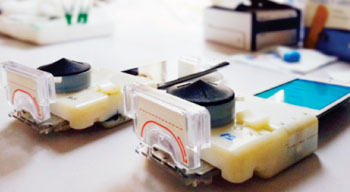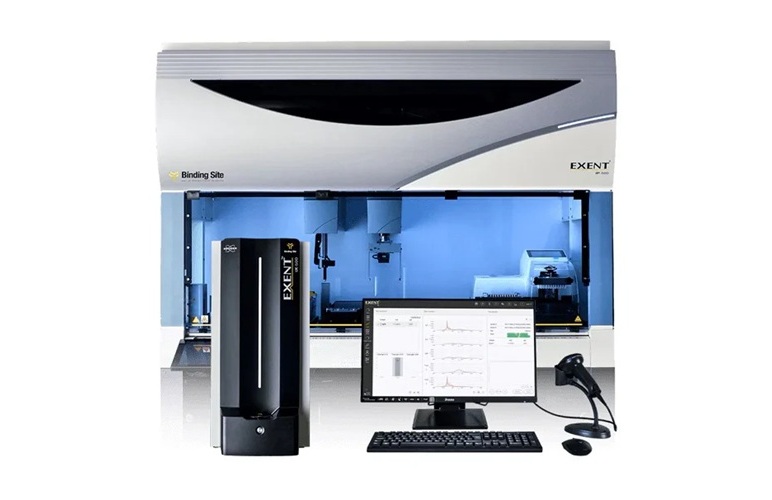A First – Smartphone Diagnostic Device Replicates Quality of Lab Blood Test
|
By LabMedica International staff writers Posted on 09 Feb 2015 |

Image: Newly developed diagnostic smartphone accessory device successfully performed point-of-care HIV and syphilis tests in Rwanda from finger-prick whole blood in 15 minutes, operated by healthcare workers easily trained via a software app (Photo courtesy of Samiksha Nayak for Columbia Engineering).
Researchers have developed a hand-held smartphone accessory that can perform a low-cost, point-of-care (POC), lab-quality test that simultaneously detects 3 infectious disease markers from a single finger-prick blood sample in only 15 minutes. The device can also be further developed to test for additional biomarkers.
In a multi-institutional collaboration, the team of researchers, led by Samuel K. Sia, associate professor of biomedical engineering at Columbia Engineering (New York, NY, USA), developed and field-tested the miniature device that, for the first time, replicates all mechanical, optical, and electronic functions of a lab-based blood test. Specifically, it performs an enzyme-linked immunosorbent assay (ELISA), without requiring stored energy as all necessary power is drawn from the smartphone. It also performs a triplexed immunoassay not currently available in a single test format: HIV antibody, treponemal-specific antibody for syphilis, and non-treponemal antibody for active syphilis infection.
Prof. Sia’s innovative accessory (or dongle) was recently piloted by healthcare workers in Rwanda, who trained via a software app then tested 96 patients from prevention-of-mother-to-child-transmission clinics or voluntary counseling and testing centers.
“Our work shows that a full laboratory-quality immunoassay can be run on a smartphone accessory,” said Prof. Sia, “Coupling microfluidics with recent advances in consumer electronics can make certain lab-based diagnostics accessible to almost any population with access to smartphones. This kind of capability can transform how health care services are delivered around the world.”
Prof. Sia’s team built upon their previous work in miniaturizing diagnostics hardware for rapid POC diagnosis of HIV, syphilis, and other sexually transmitted diseases. “We know that early diagnosis and treatment in pregnant mothers can greatly reduce adverse consequences to both mothers and their babies,” Sia notes. The team developed the dongle to be small and light enough to fit into one hand, and to run assays on disposable plastic cassettes with pre-loaded reagents, where disease-specific zones provide an objective read-out, much like an ELISA assay.
Prof. Sia estimates the dongle will have a manufacturing cost of USD 34, much lower than the USD 18,450 that typical ELISA equipment runs.
The team made two main innovations to achieve low power consumption, a must in places without dependable electricity. They eliminated the power-consuming electrical pump by using a “one-push vacuum,” where a user mechanically activates a negative-pressure chamber to move a sequence of reagents pre-stored on a cassette. The process is durable, requires little user training, and needs no maintenance or additional manufacturing. The team was able to implement a second innovation to remove the need for a battery by using the audio jack for transmitting power as well as for data transmission. And, because audio jacks are standardized among smartphones, the dongle can be attached to any compatible device (including iPhones and Android phones) in a simple plug-and-play manner.
During the field testing in Rwanda, healthcare workers were given 30 minutes of training, which included a user-friendly interface, step-by-step pictorial directions, built-in timers to alert to next steps, and records of test results for later review.
The work, by Laksanasopin T, Guo TW, et al., was published February 4, 2015, in the journal Science Translational Medicine.
Related Links:
Columbia Engineering
In a multi-institutional collaboration, the team of researchers, led by Samuel K. Sia, associate professor of biomedical engineering at Columbia Engineering (New York, NY, USA), developed and field-tested the miniature device that, for the first time, replicates all mechanical, optical, and electronic functions of a lab-based blood test. Specifically, it performs an enzyme-linked immunosorbent assay (ELISA), without requiring stored energy as all necessary power is drawn from the smartphone. It also performs a triplexed immunoassay not currently available in a single test format: HIV antibody, treponemal-specific antibody for syphilis, and non-treponemal antibody for active syphilis infection.
Prof. Sia’s innovative accessory (or dongle) was recently piloted by healthcare workers in Rwanda, who trained via a software app then tested 96 patients from prevention-of-mother-to-child-transmission clinics or voluntary counseling and testing centers.
“Our work shows that a full laboratory-quality immunoassay can be run on a smartphone accessory,” said Prof. Sia, “Coupling microfluidics with recent advances in consumer electronics can make certain lab-based diagnostics accessible to almost any population with access to smartphones. This kind of capability can transform how health care services are delivered around the world.”
Prof. Sia’s team built upon their previous work in miniaturizing diagnostics hardware for rapid POC diagnosis of HIV, syphilis, and other sexually transmitted diseases. “We know that early diagnosis and treatment in pregnant mothers can greatly reduce adverse consequences to both mothers and their babies,” Sia notes. The team developed the dongle to be small and light enough to fit into one hand, and to run assays on disposable plastic cassettes with pre-loaded reagents, where disease-specific zones provide an objective read-out, much like an ELISA assay.
Prof. Sia estimates the dongle will have a manufacturing cost of USD 34, much lower than the USD 18,450 that typical ELISA equipment runs.
The team made two main innovations to achieve low power consumption, a must in places without dependable electricity. They eliminated the power-consuming electrical pump by using a “one-push vacuum,” where a user mechanically activates a negative-pressure chamber to move a sequence of reagents pre-stored on a cassette. The process is durable, requires little user training, and needs no maintenance or additional manufacturing. The team was able to implement a second innovation to remove the need for a battery by using the audio jack for transmitting power as well as for data transmission. And, because audio jacks are standardized among smartphones, the dongle can be attached to any compatible device (including iPhones and Android phones) in a simple plug-and-play manner.
During the field testing in Rwanda, healthcare workers were given 30 minutes of training, which included a user-friendly interface, step-by-step pictorial directions, built-in timers to alert to next steps, and records of test results for later review.
The work, by Laksanasopin T, Guo TW, et al., was published February 4, 2015, in the journal Science Translational Medicine.
Related Links:
Columbia Engineering
Latest Immunology News
- Gene Signature Test Predicts Response to Key Breast Cancer Treatment
- Chip Captures Cancer Cells from Blood to Help Select Right Breast Cancer Treatment
- Blood-Based Liquid Biopsy Model Analyzes Immunotherapy Effectiveness
- Signature Genes Predict T-Cell Expansion in Cancer Immunotherapy
- Molecular Microscope Diagnostic System Assesses Lung Transplant Rejection
- Blood Test Tracks Treatment Resistance in High-Grade Serous Ovarian Cancer
- Luminescent Probe Measures Immune Cell Activity in Real Time
- Blood-Based Immune Cell Signatures Could Guide Treatment Decisions for Critically Ill Patients
- Novel Tool Predicts Most Effective Multiple Sclerosis Medication for Patients
- Companion Diagnostic Test for CRC Patients Identifies Eligible Treatment Population
- Novel Tool Uses Deep Learning for Precision Cancer Therapy
- Companion Diagnostic Test Identifies HER2-Ultralow Breast Cancer and Biliary Tract Cancer Patients
- Novel Multiplex Assay Supports Diagnosis of Autoimmune Vasculitis
- Blood Test Predicts Immunotherapy Efficacy in Triple-Negative Breast Cancer
- Simple Genetic Testing Could Predict Treatment Success in Multiple Sclerosis Patients
- Novel Gene Signature Predicts Immunotherapy Response in Advanced Kidney Cancers
Channels
Clinical Chemistry
view channel
Chemical Imaging Probe Could Track and Treat Prostate Cancer
Prostate cancer remains a leading cause of illness and death among men, with many patients eventually developing resistance to standard hormone-blocking therapies. These drugs often lose effectiveness... Read more
Mismatch Between Two Common Kidney Function Tests Indicates Serious Health Problems
Creatinine has long been the standard for measuring kidney filtration, while cystatin C — a protein produced by all human cells — has been recommended as a complementary marker because it is influenced... Read moreMolecular Diagnostics
view channel
World’s First Genetic Type 1 Diabetes Risk Test Enables Early Detection
Type 1 Diabetes (T1D) affects more than eight million people worldwide, with numbers expected to rise sharply. While most cases are genetically driven, only one in ten patients has a family history, making... Read more
Blood Test to Help Low-Risk Gastric Cancer Patients Avoid Unnecessary Surgery
Accurately identifying lymph node metastasis in early-stage gastric cancer remains a major clinical challenge. CT imaging often misses up to half of lymph node–positive cases, leading clinicians to recommend... Read moreHematology
view channel
Platelet Activity Blood Test in Middle Age Could Identify Early Alzheimer’s Risk
Early detection of Alzheimer’s disease remains one of the biggest unmet needs in neurology, particularly because the biological changes underlying the disorder begin decades before memory symptoms appear.... Read more
Microvesicles Measurement Could Detect Vascular Injury in Sickle Cell Disease Patients
Assessing disease severity in sickle cell disease (SCD) remains challenging, especially when trying to predict hemolysis, vascular injury, and risk of complications such as vaso-occlusive crises.... Read more
ADLM’s New Coagulation Testing Guidance to Improve Care for Patients on Blood Thinners
Direct oral anticoagulants (DOACs) are one of the most common types of blood thinners. Patients take them to prevent a host of complications that could arise from blood clotting, including stroke, deep... Read moreImmunology
view channel
Gene Signature Test Predicts Response to Key Breast Cancer Treatment
DK4/6 inhibitors paired with hormone therapy have become a cornerstone treatment for advanced HR+/HER2– breast cancer, slowing tumor growth by blocking key proteins that drive cell division.... Read more
Chip Captures Cancer Cells from Blood to Help Select Right Breast Cancer Treatment
Ductal carcinoma in situ (DCIS) accounts for about a quarter of all breast cancer cases and generally carries a good prognosis. This non-invasive form of the disease may or may not become life-threatening.... Read moreMicrobiology
view channel
Rapid Assay Identifies Bloodstream Infection Pathogens Directly from Patient Samples
Bloodstream infections in sepsis progress quickly and demand rapid, precise diagnosis. Current blood-culture methods often take one to five days to identify the pathogen, leaving clinicians to treat blindly... Read more
Blood-Based Molecular Signatures to Enable Rapid EPTB Diagnosis
Extrapulmonary tuberculosis (EPTB) remains difficult to diagnose and treat because it spreads beyond the lungs and lacks easily accessible biomarkers. Despite TB infecting 10 million people yearly, the... Read more
15-Minute Blood Test Diagnoses Life-Threatening Infections in Children
Distinguishing minor childhood illnesses from potentially life-threatening infections such as sepsis or meningitis remains a major challenge in emergency care. Traditional tests can take hours, leaving... Read more
High-Throughput Enteric Panels Detect Multiple GI Bacterial Infections from Single Stool Swab Sample
Gastrointestinal (GI) infections are among the most common causes of illness worldwide, leading to over 1.7 million deaths annually and placing a heavy burden on healthcare systems. Conventional diagnostic... Read morePathology
view channelAI Tool Outperforms Doctors in Spotting Blood Cell Abnormalities
Diagnosing blood disorders depends on recognizing subtle abnormalities in cell size, shape, and structure, yet this process is slow, subjective, and requires years of expert training. Even specialists... Read more
AI Tool Rapidly Analyzes Complex Cancer Images for Personalized Treatment
Complex digital biopsy images that typically take an expert pathologist up to 20 minutes to assess can now be analyzed in about one minute using a new artificial intelligence (AI) tool. The technology... Read moreIndustry
view channel
Abbott Acquires Cancer-Screening Company Exact Sciences
Abbott (Abbott Park, IL, USA) has entered into a definitive agreement to acquire Exact Sciences (Madison, WI, USA), enabling it to enter and lead in fast-growing cancer diagnostics segments.... Read more






















